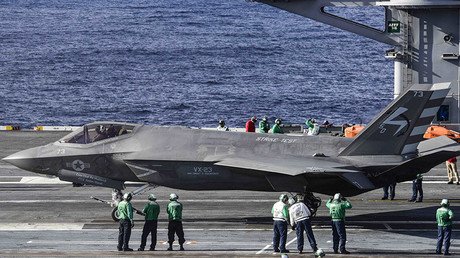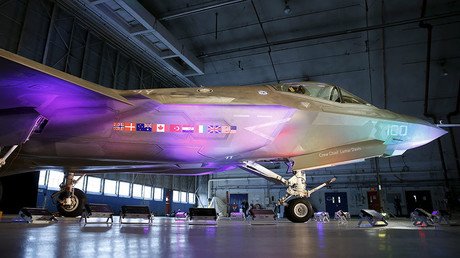Never enough: $500mn more needed for F-35, Pentagon told

The US military will have to come up with another $500 million to finish development on the F-35 Joint Strike Fighter, the Pentagon planners have been told. Despite promises, the fifth-generation jet built by Lockheed Martin is not yet combat-ready.
With a projected lifetime cost of $1.5 trillion, the F-35 is the most expensive weapons program in US history, and has been dubbed “the plane that ate the Pentagon.” Earlier this year, the Defense Department announced it would try to shave $4 billion off the program’s final price through a variety of cost-cutting measures.
The F-35 program office made the request at a closed-door meeting of the Defense Acquisition Board, according to Bloomberg Technology. Development work on the jet has already eaten up 15 years and over $55 billion. Originally scheduled to end in 2012, the development phase was extended through 2016 and given another $476 million in funding during a 2010 reorganization.
You will be stunned by the news that the F35 isn't actually combat capable and needs more money. https://t.co/q3UMo2dB3d
— Peter W. Singer (@peterwsinger) November 2, 2016
“We don't plan on going back and asking for any more money or any more time to get this program done,” Air Force Lieutenant-General Christopher Bogdan, director of the F-35 program, said at a conference in 2014.
Yet Pentagon Comptroller Mike McCord said he "wasn't totally shocked" by the funding request. "I was hopeful, maybe, that we wouldn't have a problem like this,” he said in an interview, because the program “has been moving in a fairly decent direction.”
Officially, the F-35 has already entered service in the US Marine Corps and the Air Force, with the Navy version expected to follow suit in 2018. In practice, however, the futuristic jet is plagued by more than 1,300 problems catalogued by the Pentagon inspectors, and requires more testing, patching and tweaking before it could actually replace the existing combat aircraft.
Agreed, F-35 is a cluster of fracks that is burning through money faster than a forest fire heh. https://t.co/lyW5h7vin9
— Tim Verry (@timverry) November 2, 2016
Undersecretary of Defense for Acquisition Frank Kendall said in an email that he was “disappointed to hear that additional funds would be needed” and that the Pentagon was “working to minimize the size of the shortfall and to deliver options to address it,” Bloomberg reported.
The additional funds would need to be allocated in the Pentagon’s budget proposal for the fiscal year 2018, and will likely be the first decision related to the F-35 for the next defense secretary.
The F-35 was originally envisioned as a cost-saving modular design with specific versions tailored to different service branches. The Marines declared their F-35B operational in July 2015, while the Air Force following with the F-35A in August this year. The Navy’s F-35C is the priciest version, and is expected to become operational in 2018.
In September, however, the Air Force had to ground all of its F-35s after a manufacturing problem that caused two jets to burst into flames. Poorly built insulation material was “crumbling” into fuel tanks, the Air Force found.
Cutting one faulty weapons program, the F-35, would pay for education for all students in US colleges for 23 years. #Prioritiespic.twitter.com/Sq5e2QuH7Y
— Dr. Jill Stein (@DrJillStein) November 2, 2016
On October 14, the Pentagon’s director of operational testing Michael Gilmore sent a memo detailing the problems with the jet, including the main gun’s design deficiencies, too few aircraft available for testing, and over 1,000 “significant” problems with the plane’s sophisticated software. Gilmore recommended that the program be restructured again and “provided the additional resources it clearly requires to deliver its long-planned and sorely needed” full capability, Bloomberg reported.
Test flights required to complete the development phase would not be done before November 2018 at the earliest, Gilmore said, noting the tests were needed to “to rectify a substantial number of existing critical deficiencies as well as the new deficiencies that will inevitably be discovered.”














